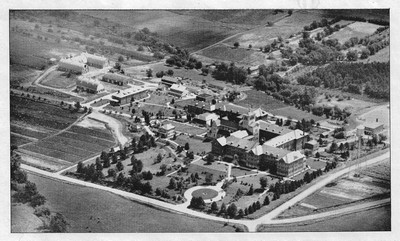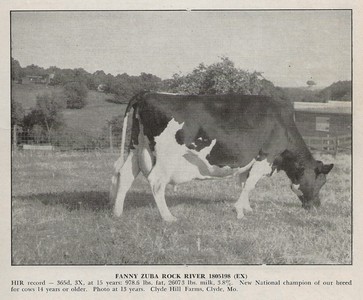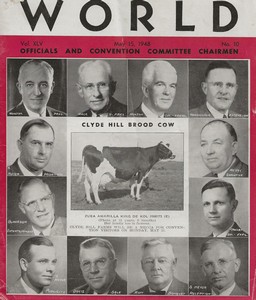This article was featured in our Fall 2020 issue and is written by Doug Urban.

Located in the northwest corner of Missouri in Clyde located on a hillside in Nodaway County is the Benedictine Convent of Perpetual Adoration which was founded in December, 1875, by three Sisters from Switzerland. They established a humble convent which grew into a thriving Congregation of two hundred sixty nuns. The property eventually included a group of well-developed and solidly constructed farm buildings and the Adoration Chapel which is a gem of architectural beauty. The Sisters followed a well-balanced program of prayer and work. They prayed for the needs of all mankind, without interruption, continually both day and night, at the Motherhouse of Clyde, since March 28, 1878. They also operated a printing press and printed a magazine and several devotional booklets, constructed linens, and made Communion wafers. The farm connected with the Clyde convent provided all the milk, butter, pork, beef, eggs, and vegetables for the institution, which daily fed between 250-300 persons including employees and visitors. The dairy farm purchased its first purebred Holsteins in 1918.

The Sisters found the need for experienced help and Joseph Gemmeke of West Germany moved to the United States in 1923 where he went to work for the Sisters at Clyde Hill. Joe was a hard worker and by 1930 he became the herd manager. Joe had the “Masters Touch” as far as breeding purebred Holsteins and a few prominent Missouri agriculturists admired the size, production and conformation of the herd. They persuaded Joe and the humble Sisters to enroll the herd in the Holstein Association’s Herd Improvement Registry (production testing) and type classification programs. It was through these programs that the Clyde Hill herd gained national attention. The “Clyde Hill “ prefix was first used in 1938 and continued until the herd was sold privately in 1963.
Dairy cattle breeders have always promoted the importance of cow families. In 1932 a cow was born at Clyde Hill that would greatly influence the herd and Holstein breed. Zuba Amarilla King De Kol EX-92 GMD was known as the “Queen Mother of Clyde Hill” because of her ability to transmit type, production and longevity. Zuba was the third generation born at Clyde Hill and was the result of a linebreeding program centered around the bull King Pietertje Ormsby Piebe (KPOP). She lived to be nearly 17 years old and had a lifetime production of 225,232 lbs. of milk and 7,317 lbs. of fat. This record does not include her first 2 lactations when the herd was not on DHIA test. During her fourth lactation she jumped a barbwire fence and lacerated her udder. The Sisters decided that she needed to be slaughtered, but herd manager Joe Gemmeke decided to dry her up and keep her at Clyde Hill. It was a wise decision as Zuba would calve nine more times and made many outstanding records. She was the dam of 13 offspring, three daughters and ten sons. Ten of the offspring were  sired by the great herd sire Rock River Hengerveld Al EX-GM who was purchased in Illinois in 1932. Zuba was the first cow to score EX and have four EX offspring-two sons and Elsie and Fanny. Her first two calves were females. Elsie Zuba Rock River EX-92 GMD with lifetime production of 160,743M and 5,805F. Elsie’s influence would come through her Sir Bess Ormsby Tidy Fobes son Clyde Hill Elsie Tidy Lad VG-GM whose daughter Clyde Hill May Belle Tidy Lad VG was the dam of Raven Burke Elsie EX-91 GMD the Elmer Dawdy cow in Kansas who had three influential sons Ideal Burke Elsie Leader EX-GM, Raven Burke Ideal EX-GM, and Ormsby Burke Pontiac Mose EX-GM. The second daughter Fanny Zuba Rock River EX-92 with lifetime production of 257,841M and 9,039F. Fanny produced eight daughters, six of them rated Very Good. Her Sir Bess Ormsby Tidy Fobes daughter Clyde Hill Queen Fanny Tidy VG would complete the breed’s first 3-generation group of Excellents with over 200,000 lbs. of milk. “Old Zuba” would then have 8 bulls in a row until 1945 when her third daughter Clyde Hill Rosetta Zuba Rock VG-86 was born. Further study of the pedigrees of the Clyde Hill herd showed as many as 7-generations of cattle descending from “Old Zuba” in the years prior to selling the herd in 1963.
sired by the great herd sire Rock River Hengerveld Al EX-GM who was purchased in Illinois in 1932. Zuba was the first cow to score EX and have four EX offspring-two sons and Elsie and Fanny. Her first two calves were females. Elsie Zuba Rock River EX-92 GMD with lifetime production of 160,743M and 5,805F. Elsie’s influence would come through her Sir Bess Ormsby Tidy Fobes son Clyde Hill Elsie Tidy Lad VG-GM whose daughter Clyde Hill May Belle Tidy Lad VG was the dam of Raven Burke Elsie EX-91 GMD the Elmer Dawdy cow in Kansas who had three influential sons Ideal Burke Elsie Leader EX-GM, Raven Burke Ideal EX-GM, and Ormsby Burke Pontiac Mose EX-GM. The second daughter Fanny Zuba Rock River EX-92 with lifetime production of 257,841M and 9,039F. Fanny produced eight daughters, six of them rated Very Good. Her Sir Bess Ormsby Tidy Fobes daughter Clyde Hill Queen Fanny Tidy VG would complete the breed’s first 3-generation group of Excellents with over 200,000 lbs. of milk. “Old Zuba” would then have 8 bulls in a row until 1945 when her third daughter Clyde Hill Rosetta Zuba Rock VG-86 was born. Further study of the pedigrees of the Clyde Hill herd showed as many as 7-generations of cattle descending from “Old Zuba” in the years prior to selling the herd in 1963.

At the start of World War II three of the Clyde Hill employees who milked the cows by hand had to leave for the army on short notice. It was noted that several of the Sisters took over the 3X per day milking and did a fine job which lead to annual increases in production. Eventually a milking machine was installed. Heading the contingent of quiet, careful workers was Sister M. Liguori who handled the registrations, knew every animal in the herd, its ancestry and life history. Sister Josephine was in charge of the farming operations for over 25 years and was credited with building up the fertility of the land and pastures, the erection and maintenance of an impressive collection of farm buildings, and the establishment and development of outstanding herds of registered Holsteins and Aberdeen Angus. The beef herd was added to provide meat for the institution as demand for Holstein breeding bulls increased.
The Clyde Hill herd was the subject of many articles in the Holstein-Friesian World and individuals from the herd appeared on the cover four times and was a regular advertiser. The herd developed many outstanding individuals by linebreeding to the Rock bull and “Old Zuba”. This concentration of Rock and Zuba shows the pedigrees of most of the animals in the herd with 3 crosses to Rock and 3 crosses to Zuba, others with 2 to Zuba and 4 to Rock. These matings produced offspring that were in demand around the United States. Eight cows in the herd produced over 200,000 lbs. of milk in a lifetime. The herd received the Progressive Breeders Award 19 times.
It is interesting to note that Rock River Hengerveld Al EX-GM was developed, and eight Gold Medal sires were bred at Clyde Hill. Round Oak Rag Apple Elevation EX-96-GM, Paclamar Bootmaker EX-94-GM, Robthom Integrity EX-96-GM, To-Mar Blackstar EX-93-GM have the influence through the genetics of one or more Clyde Hill individuals. Rock River Hengerveld Al was the chief carrier of mulefoot or syndactylism in the Holstein breed, a genetic recessive characterized by the fusion or non-division of the hoof. He appears in the pedigree of Raven Burke Elsie EX-91 GMD whose sons, Raven Burke Ideal and Ideal Burke Elsie Leader were mulefoot carriers. In the late 1970s Wayne Spring Fond Apollo was identified as a mulefoot carrier. His maternal granddam was a Raven Burke Ideal daughter. At the time Wayne was the highest PDM bull and also had a high type proof. It was decided to leave him in service and to test his sons for this gene before placing them in A.I.
 Roland Ramsey wrote in the Holstein-Friesian World of the Clyde Hill herd, “We wish to pay tribute to Joe Gemmeke and the people who work with this great herd. When you visit Clyde Hill, watch them milk and care for their cattle, you cannot help but realize what a great part love, tender care and good “cow sense” has played in the development of this herd—and what a great part it could play in your own herd. No one knows how many “Rocks” or “Zubas have passed by unnoticed, undeveloped and undiscovered in our various herds due to lack of applying just a part of the understanding care that those at Clyde Hill give their cattle.”
Roland Ramsey wrote in the Holstein-Friesian World of the Clyde Hill herd, “We wish to pay tribute to Joe Gemmeke and the people who work with this great herd. When you visit Clyde Hill, watch them milk and care for their cattle, you cannot help but realize what a great part love, tender care and good “cow sense” has played in the development of this herd—and what a great part it could play in your own herd. No one knows how many “Rocks” or “Zubas have passed by unnoticed, undeveloped and undiscovered in our various herds due to lack of applying just a part of the understanding care that those at Clyde Hill give their cattle.”
